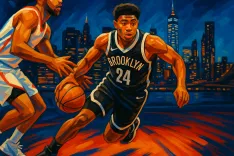Knicks Face Uphill Battle After Game 2 Loss to Pacers

The Indiana Pacers staged a remarkable comeback in Game 1, prompting a notable response from the New York Knicks in Game 2. Following their 114-109 defeat on Friday, the Knicks now find themselves in a precarious position as they head on the road for the next matchup. Historically, no team in NBA history has managed to lose the first two games of a conference finals series at home and then win the series. However, the Knicks will look to defy the odds, but they must improve significantly from their performance at Madison Square Garden.
To prevail in the remaining games, the Knicks must address several key issues. Although they have succeeded in slowing down the Pacers' transition game compared to the regular season, Indiana still thrives on fast-paced play. The Pacers excel when they can push the ball up the court quickly, bypassing dribbling and catching defenses off guard. The Knicks will need to focus on transitioning back defensively with greater urgency, regardless of whether their opponents score or miss. A more methodical offensive approach may also be beneficial, as forcing the Pacers to defend longer possessions could diminish their energy levels.
In the first two games of the series, the Knicks have struggled with ball distribution, recording only 18 assists in Game 2. Over half of their baskets came without assists, which, coupled with Jalen Brunson's 52 field-goal attempts across the two contests, indicates that the Knicks are not fully exploiting the Pacers' defensive setup. The Pacers present a diverse array of scoring options, demanding constant vigilance from all five defenders. While isolations and pick-and-rolls feature prominently in New York's playbook, excessive reliance on these strategies can lead to predictability, allowing defenders to rest rather than maintain relentless pressure on the offense.
Despite a historical average of 27.5 assists per game during the regular season, the Knicks have yet to tap into that capability as effectively. The disparity in three-point shooting also deserves attention; the Knicks have trailed the Pacers by six (or 18 points) in total three-pointers made. This gap is significant, particularly considering the crucial moments in Game 1 where Aaron Nesmith found success behind the arc, and New York's perimeter defense did not match his intensity. Overall, the Knicks must improve their rotations to contest three-point shots, potentially embracing more aggressive switching on the perimeter, especially since Myles Turner is not a traditional post-up threat.
Additionally, recognizing and neutralizing Pascal Siakam is essential. With an average of 20.2 points per game during the regular season, Siakam has shown the ability to take over games, as evidenced by his 39-point performance in Game 2. While defending against a player with such diverse scoring ability can be challenging, the Knicks may need to consider occasionally doubling him to disrupt his rhythm. In contrast, alternating between zone and man-to-man defensive schemes could add an element of unpredictability, though caution is warranted against a team like the Pacers with strong shooting capability.
Lastly, bench contributions are vital in close series. Currently, the Pacers hold a significant advantage in bench scoring, leading 52-28 over the Knicks through two games. Key players such as OG Anunoby and Jalen Brunson are logging substantial minutes, with the potential for fatigue to become a factor. If the Knicks can receive even a modest uptick in three-point production from role players like Miles McBride or Cameron Payne, it could provide much-needed relief for their main contributors. In a tightly contested series, one unexpected player stepping up could be the difference-maker in shifting the momentum.









